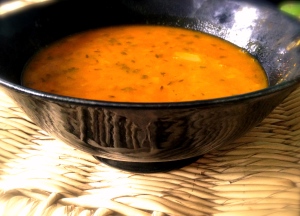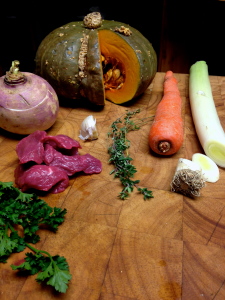This post is also available in: Kreyol
There are no memories before soup joumou
There are no memories before soup joumou. There is no marker in the mind for when this food was introduced to my body. As long as I’ve been collecting the trinkets of my days as souvenirs in my mind, there has been pumpkin soup.
When I dig through the library of remembrance in my brain to find the scrapbook labeled “soup joumou”, it is a thick and heavy one. If each time I’ve eaten this soup is a photograph, there is a tall pile of images shoved into this scrapbook. They are all messily taped, crooked and wrinkled. Some are just crammed in with no consideration. It had never occurred to me that pumpkin soup memories deserved any special respect, any thought at all, really. They are as much a part of the fabric of my life as sunlight or rooster crows or Kreyòl.
It is a grey winter day in Vermont right now. I sit in my kitchen and look out the window. My view is partially obscured by icicles hanging from the roof. I haven’t heard a rooster crow since the last time I was in Haiti and kreyol is a handful of words that roll around in my head silently like stones in a river. So, now I think of this soup. I crave it in the same way my ears want to hear someone call me “ti cheri mwen” or to feel the sense of home wash over me when a rooster calls out in the night. And my skin needs sun.
And isn’t that what soup joumou is? Just a bowl of sunshine, a pot of home, a vessel that delivers Haiti straight to your mouth so you can take it in and feel one more knot in the cord that binds us all together to our ancestors?
This soup is a concept. It is a tradition. It is a symbol. it is a certificate of participation. It is proof of identity. One day, hundreds of years from now, will archeologists or geneticists or whoever it is that does this work take a tissue sample from a body and know it is Haitian because those cells have a consistent presence of joumou DNA?
I will know who you are depending on your response to this question: What is the first thing you eat on January first?
I will know who you are depending on your response to this question: What is the first thing you eat on January first? If it’s anything other than “soup joumou” we can be tight yet we are not kin. This soup is the first thing that slides over my tastebuds when everyone around me celebrates a new year.
 Pumpkin soup was created by the Haiti’s very first first lady, the Empress Marie Claire Heureuse Félicité Bonheur Dessalines, as the perfect food to fuel the freedom fighters that rose up against the colonialists and slashed and burnt our way to independence. That is why we eat it on January 1st. This day signals to most of this hemisphere a New Year has begun but to Haitians, it is our Independence Day.
Pumpkin soup was created by the Haiti’s very first first lady, the Empress Marie Claire Heureuse Félicité Bonheur Dessalines, as the perfect food to fuel the freedom fighters that rose up against the colonialists and slashed and burnt our way to independence. That is why we eat it on January 1st. This day signals to most of this hemisphere a New Year has begun but to Haitians, it is our Independence Day.
Pumpkin soup is actually made with a squash, known here in the United States as a kabocha squash. Its flesh is bright orange. When pureed or mashed, it is meaty and smooth and sweet yet savory. It can be made with any meat or without any at all. Each household’s is as unique as the culture of the house. My father insisted that there be celery or it wasn’t pumpkin soup. I don’t need the celery and find thyme mandatory. If other vegetables are introduced after the kabocha is pureed, they must be sliced into rounds. They represent coins for prosperity. However, all that’s really needed for this soup is the squash and some water. And salt. Always, salt.
 Kabocha, as are nearly all the squashes, wonderful food. When boiled and pureed with a fat (Butter is my favorite and I average 1/2 a stick to 1 stick per kabocha, however, lard is the most traditional.), they are highly digestible and the nutrients are readily available to the body. I love to use soups and boiled squash purees for those with impaired digestion or who aren’t feeling well yet can handle something a little more substantial than broths.
Kabocha, as are nearly all the squashes, wonderful food. When boiled and pureed with a fat (Butter is my favorite and I average 1/2 a stick to 1 stick per kabocha, however, lard is the most traditional.), they are highly digestible and the nutrients are readily available to the body. I love to use soups and boiled squash purees for those with impaired digestion or who aren’t feeling well yet can handle something a little more substantial than broths.
It is low in carbohydrates yet high in vitamins and minerals. When blended with the fat, your body is better able to convert and use the vitamins A, E, and K. It is high in potassium, copper and molybdenum. The fiber content is low, which makes it wonderful for those who have irritated digestive systems yet you can up the fiber if your body is stronger by just boiling and pureeing the skins along with the flesh.
Photo credit: Jennifer Martineau
